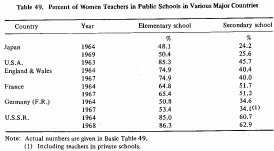| Home > Policy > White Paper, Notice, Announcement > White Paper > EDUCATIONAL STANDARDS IN JAPAN 1971 > CHAPTER |
||
As for the structure of the teaching staff by sex, the percent of women teachers both in elementary and lower secondary schools have been increasing in recent years, especially in elementary schools where women teachers account for half of the total. In upper secondary schools, in contrast to both school levels mentioned, the percent of women teachers is declining.

Note: Actual numbers are given in Basic Table 48 Basic Table 48
In contrast to the high percent of women teachers in elementary schools, however, the composition of principals by sex shows that the proportion of women principals in elementary schools was very low, accounting for only 0.9% (200principals) in 1970. Likewise, the number of women vice-principals of local public elementary schools was small (483 vice-principals in 1970), the total of women principals and vice-principals accounting for only l.5% of all the elementary school principals and vice-principals.
Every other major country has a higher percentage of women teachers in elementary and secondary schools than Japan, especially the U.S.S.R. and the United States of America where more than 85% of the teachers in public elementary schools are women. The percent of women principals in elementary schools (four-year course) in the U.S.S.R. amounted to 78% in 1968.

Note: Actual numbers are given in Basic Table 49 Basic Table 49
| Back to Top | MEXT HOME |